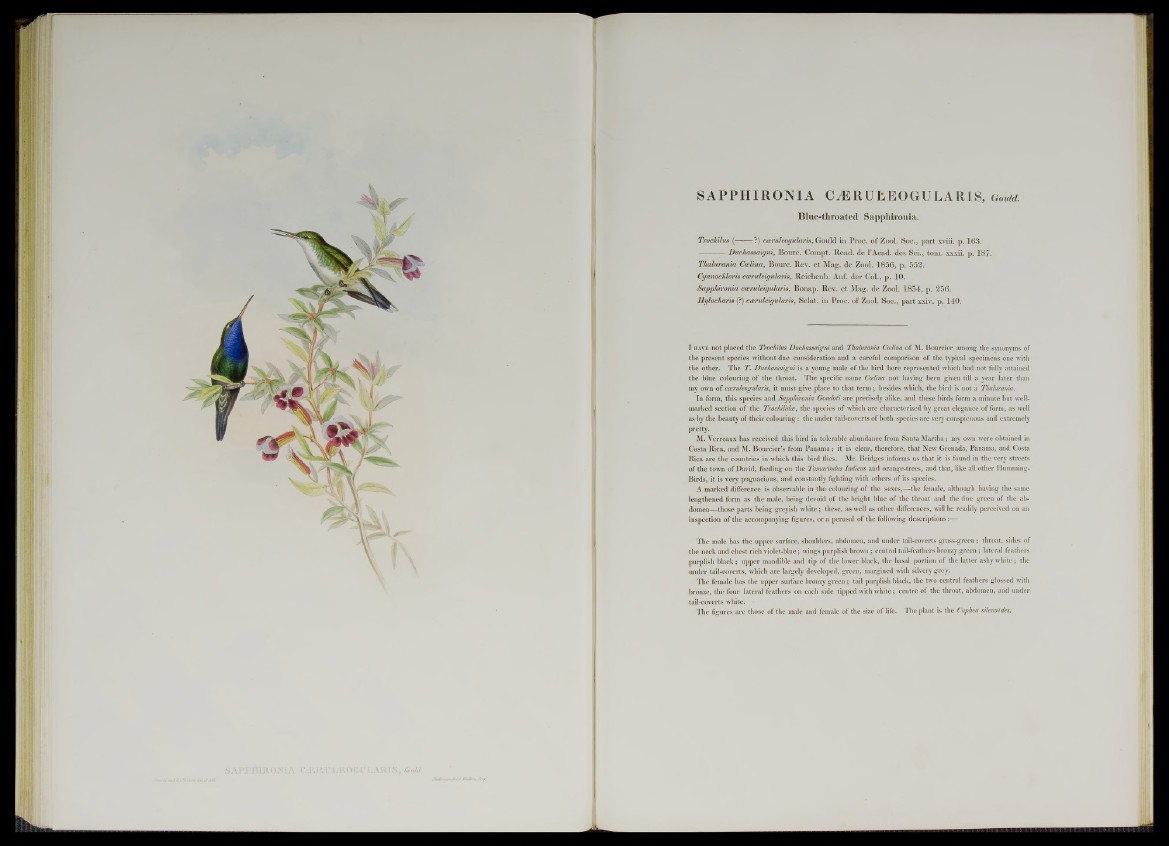
SAPPHIRONIA CÆRULEOGULARIS, GouU.
Blue-throated Sapphironia.
Trochilus (------- ?) caruleogularis, Gould in Proc. o f Zool. Soc., p a rt xviii. p. 163.
Duclia88aigni, Bourc. Compt. Rend, de l’Acad. des Sci., tom. xxxii. p. 187.
Thalurania Coelina, Bourc. Rev. e t Mag. de Zool. 1856, p. 552.
Cyanochloris coeruleigula-ris, Reichenb. Auf. der Col., p. 10.
Sapphironia cceruleigularis, Bonap. Rev. e t Mag. de Zool. 1854, p. 256.
Hylochari8 (?) coeruleigularis, Sclat. in Proc. o f Zool. Soc., p a rt xxiv. p. 140.
1 h a v e not placed the TVochilus Duchassaigni and Thalurania Coelina of M. Bourcier among the synonyms of
the present species without due consideration and a careful comparison of the typical specimens one with
the other. The T. Duchassaigni is a young male of the bird here represented which had not fully attained
the blue colouring of the throat. The specific name Coelina not having been given till a year later than
my own of coeruleogularis, it must give place to that term; besides which, the bird is not a Thalurania.
In form, this species and Sapphironia Goudoti are precisely alike, and these birds form a minute but well-
marked section of the Trochilidoe, the species of which are characterized by great elegance of form, as. well
as by the beauty of their colouring: the under tail-coverts of both species are very conspicuous and extremely
pretty.
M. Verreaux has received this bird in tolerable abundance from Santa Martha; my own were obtained in
Costa Rica, and M. Bourcier’s from Panama; it is clear, therefore, that New Grenada, Panama, and Costa
Rica are the countries in which this bird flies. Mr. Bridges informs us that it is found in the very streets
of the town of David, feeding on the Tamarindus Indicus and orange-trees, and that, like all other Humming-
Birds, it is very pugnacious, and constantly fighting with others of its species.
A marked difference is observable in the colouring of the sexes,—the female, although having the same
lengthened form as the male, being devoid of the bright blue of the throat and the fine green of the abdomen—
those parts being greyish white; these, as well as other differences, will be readily perceived on an
inspection of the accompanying figures, or a perusal of the following descriptions:—
The male has the upper surface, shoulders, abdomen, and under tail-coverts grass-green; throat, sides of
the neck and chest rich violet-blue; wings purplish brown; central tail-feathers bronzy green; lateral feathers
purplish black; upper mandible and tip of the lower black, the basal portion of the latter ashy w hite; the
under tail-coverts, which are largely developed, green, margined with silvery grey.
The female has the upper surface bronzy green; tail purplish black, the two central feathers glossed with,
bronze, the four lateral feathers on each side tipped with white; centre of the throat, abdomen, and under
tail-coverts white.
The figures are those of the male and female of the size of life. The plant is the Cuphea silenoides.